 After initial resistance, the brewer SAB Miller last week agreed to a merger with Anheuser-Busch InBev (AB InBev). The merging parties own over 400 brands between them. These include Budweiser, Stella Artois and Beck’s, which are owned by AB InBev, and Peroni and Grolsch by SAB Miller. Furthermore, they are currently the number one and two firms in the market respectively. If the merger goes ahead the new entity would control almost one third of global beer production.
After initial resistance, the brewer SAB Miller last week agreed to a merger with Anheuser-Busch InBev (AB InBev). The merging parties own over 400 brands between them. These include Budweiser, Stella Artois and Beck’s, which are owned by AB InBev, and Peroni and Grolsch by SAB Miller. Furthermore, they are currently the number one and two firms in the market respectively. If the merger goes ahead the new entity would control almost one third of global beer production.
This merger represents the continuation of AB InBev’s aggressive expansion plans through mergers and acquisitions as it follows its merger with Interbrew in 2004 and with InBev in 2008. It seems that one key attraction of a merger with SAB Miller is its dominant position in rapidly growing African markets.
A second motivation for the merger appears to be an attempt to counter the rise of small independent craft beer producers. For example, in the USA craft beer’s share of the market has grown from 5 to 11% since 2011. It has been suggested that the leading breweries combining forces represents one of several strategies being used to try to counter the threat of craft breweries. Additional strategies include creating their own craft products that are marketed as independant products and attempting to buy-up craft beer producers. For example, in 2011 AB InBev purchased the Goose Island brand.
Commenting on the planned merger between SAB Miller and AB InBev, a spokesman for the Campaign for Real Ale group expressed concern that:
independent beers may find it harder to get space in pubs and supermarkets because of the increased market presence of AB InBev.
Given the market positions of SAB Miller and AB InBev, it is likely that their merger will face considerable scrutiny by competition agencies in a number of jurisdictions. In fact it has been reported that plans have already been set in motion to sell SAB Miller’s interests in the USA to try to placate potential concerns from competition agencies in the USA and China.
Interestingly, SAB Miller has also protected itself by negotiating a clause that requires AB InBev to pay it $3bn if the deal falls through, for example on competition grounds. It remains to be seen what conditions competition authorities will require before the merger can go ahead and it is even possible they will try to completely block the deal.
Why beer drinkers lose in the SABMiller-AB InBev merger Fortune, John Colley (13/10/15)
Can craft beer survive AB InBev? The Budweiser maker’s acquisitions are unsettling the craft movement Bloomberg Business, Devin Leonard (25/06/15)
Questions
- How important do you think it is to consumers who a particular brand of beer is produced by?
- How serious a threat do you think independent craft beer producers are to the leading breweries?
- Outline some of the factors competition agencies will look at when they consider the merger between SAB Miller and AB InBev.
- Why might AB InBev have been willing to agree to pay a fee to SAB Miller in the event of the merger falling through?
 For some people, a pint of beer is a regular thing each week. Add all your pints of beer together, then add your friend’s pints, their friends’ pints and … you get the idea. Once you’ve done that for the entire population, you have an estimate of total beer consumption in the UK. This can then be compared with total consumption of beer in other countries and between continents.
For some people, a pint of beer is a regular thing each week. Add all your pints of beer together, then add your friend’s pints, their friends’ pints and … you get the idea. Once you’ve done that for the entire population, you have an estimate of total beer consumption in the UK. This can then be compared with total consumption of beer in other countries and between continents.
Prior to 2007, Europe and the Americas were the biggest beer drinking continents, but since then, Asia has emerged as the leader of pints of beer consumed, drinking 67bn litres of beer compared with the Americas’ 57bn and Europe’s 51bn in 2011. In per capita terms, Asia is still some way off, with Japan leading the way as the highest Asian country in 41st place, consuming 64 litres of beer per year per capita of the population. So how is this relevant to economics and business?
 Consumption of anything provides jobs – bar workers, manufacturers and in the case of beer, probably law enforcement! It probably also increases utility – after all, why consume it if it’s not going to give you some degree of satisfaction!
Consumption of anything provides jobs – bar workers, manufacturers and in the case of beer, probably law enforcement! It probably also increases utility – after all, why consume it if it’s not going to give you some degree of satisfaction!
We can analyse the demand for beer and see how it varies with changes in price and income. Minimum prices for alcohol have been proposed as a means of reducing consumption, and tax and excise duties are always linked to alcoholic beverages and clearly have an effect on demand. In this case, however, we can also consider the emergence of Asia and how tastes have changed. It is the fastest growing beer market in the world; so what can we deduce from that? As the BBC News article states, it is ‘a sign of a young, upwardly mobile, and increasingly hedonistic population.’
Experts also say that the increased consumption of beer in Asian countries is closely correlated with growing incomes and prosperity. A consumer research analyst from Standard Chartered, Nirgunan Tiruchelvam, said:
“Beer has a clearer correlation with strong economic growth … People tend to drink beer in times of growth. They drink spirits when times are good and when times are bad.”
Data suggest that when a certain level of prosperity is reached in a nation, beer sales begin to rise. As many Asian economies begin to develop rapidly, beer sales have taken off. This could be regarded as a good thing for Europe. With stagnant Western economies, beer producers within Europe may be grateful for a growing demand in Asia. Indeed, many of the world’s biggest breweries are expanding rapidly, providing jobs and income. Consumers in Europe will also be happy to see that beer production remains profitable in other parts of the world. With unemployment still high and recession ongoing, a pint of beer will be a much needed pick-me-up for many people. At least, that’s what the evidence from the Great Depression of the 1930s suggested!!
It’s not good news for everyone, however. Beer production has also increased in Asian countries, most notably in China, which now leads the world as the largest beer producer. This clearly reduces the export potential for European beer producers.
Also, many argue that the growing consumption of beer in Asia is simply an illustration of growing Western influence and it is likely to create severe medical problems in the future. Binge drinking and under-age consumption is already a big problem in Western countries and this could soon begin to extend across the world. The following articles consider the growth in consumption of beer.
Brewers thirsty for expansion as taste for beer grows in emerging markets Guardian, Simon Neville (3/9/12)
Beer in Asia: the drink of economic growth BBC News, Saira Syed (6/9/12)
Study says world beer production hits new high Long Island Business News, Associated Press (8/8/12)
Global beer sales go up for 27th year running News Track India (9/8/12)
Questions
- Use a supply and demand diagram to analyse recent trends in beer consumption across the world.
- Which factors have caused demand in emerging markets to increase? Based on your answer to the previous question, how might that have affected equilibrium prices?
- How has growth in beer consumption throughout Asia benefited Western producers?
- What would you expect the price and income elasticities of demand to be for a product such as beer? Explain your answer.
- To what extent do you think this trend in beer production is a sign of globalisation?
- Evaluate the extent to which the growth in consumption and production of beer in Asia is a good thing. You should consider everyone who and everything might be affected!
We frequently hear about two companies merging with each other, whether for certainty, market share or economies of scale. However, in this case, we’re looking at a de-merging of one company to create two companies. Foster’s will be split to create two stand-alone companies.
With Foster’s retaining its beer business, a new company called Treasury Wine Estates will take over its ailing wine division. This split comes after 99% of investors cast their votes in favour of the split. The future profitability of this demerger is uncertain and how the stocks of the two separate companies trade in the coming months will give a clear indication of whether or not this divorce is the right move.
Foster’s votes to split beer and wine business Telegraph, Richard Fletcher and Jonathan Sibun (29/4/11)
Investors agree to split Foster’s into beer, wine units BBC News (29/4/11)
Two halves: Foster’s to split its beer and wine operations Mail Online (29/4/11)
Foster’s wine-beer demerger to clarify divisions’ value The Australian (30/4/11)
Questions
- What type of de-merger could we call this?
- How do you think the share prices of the 2 separated companies will fare following the de-merger?
- How concentrated is the beer and wine market? What effect will the de-merger have?
- In the BBC News article, Donald Williams says ‘The wine business needs a better pricing environment before it is likely to perform.’ What does this mean?
- Why has the wine division been a financial drain for so long?
 After initial resistance, the brewer SAB Miller last week agreed to a merger with Anheuser-Busch InBev (AB InBev). The merging parties own over 400 brands between them. These include Budweiser, Stella Artois and Beck’s, which are owned by AB InBev, and Peroni and Grolsch by SAB Miller. Furthermore, they are currently the number one and two firms in the market respectively. If the merger goes ahead the new entity would control almost one third of global beer production.
After initial resistance, the brewer SAB Miller last week agreed to a merger with Anheuser-Busch InBev (AB InBev). The merging parties own over 400 brands between them. These include Budweiser, Stella Artois and Beck’s, which are owned by AB InBev, and Peroni and Grolsch by SAB Miller. Furthermore, they are currently the number one and two firms in the market respectively. If the merger goes ahead the new entity would control almost one third of global beer production.
